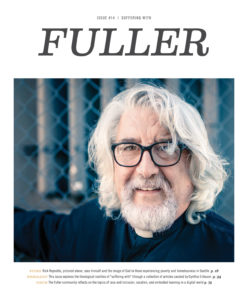
The natural human response to pain is withdrawal. We hide, avoid, numb, deflect, and blame. It is normal to protect oneself. But the gospel tells a different story: Jesus is moved with compassion. Jesus weeps and cries out. Jesus goes to the cross, and Jesus reaches with forgiveness into the pain of betrayal. Jesus suffers with.
We are all called to be present in suffering. Present to the reality of our own pain (Phil 3:10). Present to God with the truth of our deep emotions (Ps 88). Present to our loved ones as their pain rips a hole in our comfort (John 11:33–35). And present to the suffering of the oppressed, the poor, and the marginalized (Ps 82:3; Rom 12:15).
Yet sometimes in our faith communities, suffering may be spoken only after the rescue has come. We value the testimony of triumph, while it is harder to swallow a testimony of pain, confusion, loss, disappointment, or anger toward God.
That is why suffering with is so very important.
The “with-ness” in suffering has many postures. It can be a commitment to walking the journey together. Jude Tiersma Watson and Chris Albisurez describe the gift of mutual transformation made possible by vulnerably sharing painful stories. Mary Glenn writes of the unique challenge of walking with those experiencing the pain of suicide.
“With-ness” can also be honest leadership that models pain and uncertainty. As Eun Ah Cho challenges us, we do not serve our community or Christ when we keep others away from our suffering. Sarah Ashley Hill describes the importance of showing the messy journey of pain, in particular for leaders in places where trauma is embedded in daily life. Ed Willmington calls us to suffer with those who are suffering for the sake of the gospel.
How do we walk in the presence of real joy and real pain? Daniel Lee reminds us to suffer unabashedly with God, with lament and imprecation. Alexia Salvatierra examines Latin American views of suffering, offering a perspective of redemptive suffering that leads to liberation. I encourage us to consider the discipline of making space for the transformative work of Christ in our own lives, even as we open our hearts to hold, feel, and digest the pain of others.
There is hope. It is in the living and suffering with that we grow, “knowing that suffering produces endurance, and endurance produces character, and character produces hope” (Rom 5:3–4).
Hope is not in withdrawal. It is in WITH!

La respuesta humana natural al dolor es evitarlo. Nos escondemos, evitamos, entumecemos, desviamos y culpamos. Es normal protegerse a uno/a mismo/a. Pero, el evangelio cuenta una historia diferente.
Jesús es movido a compasión. Jesús llora y clama. Jesús va a la cruz, y Jesús alcanza con perdón el dolor de la traición. Jesús sufre en compañerismo.
Todos estamos llamados/as a estar presentes en el sufrimiento. Presentes a la realidad de nuestro propio dolor (Filipenses 3:10). Presentes a Dios con la verdad de nuestras emociones profundas (Sal 88). Presentes a nuestros seres queridos, ya que su dolor hace un agujero en nuestra comodidad (Juan 11: 33–35). Y presentes al sufrimiento de las oprimidas, los pobres y los marginados (Sal 82: 3; Rom 12:15).
Sin embargo, en nuestras comunidades de fe, se habla de sufrimiento solo después de que haya llegado el rescate. Valoramos el testimonio de triunfo, mientras que es más difícil tragar un testimonio de dolor, confusión, pérdida, decepción o enojo hacia Dios.
Por eso es tan importante el sufrir en compañerismo con
los/as demás.
El sufrimiento con los demás tiene muchas posturas. Puede ser un compromiso de hacer el viaje juntos. Jude Tiersma Watson y Chris Albisurez describen el don de la transformación mutua que fue posible por el vulnerable intercambio de historias dolorosas y de trauma. Mary Glenn escribe sobre el desafío único de caminar con quienes experimentan el dolor del suicidio.
El sufrimiento con los demás también puede ser un liderazgo honesto que modela el dolor y la incertidumbre. Como Eun Ah Cho nos desafía, no servimos a nuestra comunidad ni a Cristo cuando mantenemos a otros alejados de nuestro sufrimiento. Sarah Ashley Hill describe la importancia de mostrar el desordenado viaje del dolor, en particular para los líderes en lugares donde el trauma está incrustado en la vida diaria. Ed Willmington, a su vez, nos llama a sufrir con aquellos que están sufriendo por el bien del evangelio.
¿Cómo caminamos en presencia de verdadera alegría y verdadero dolor? Daniel Lee nos recuerda que debemos sufrir abiertamente con Dios, con lamento e imprecación. Alexia Salvatierra examina la visión latinoamericana del sufrimiento, ofreciendo una perspectiva del sufrimiento redentor que conduce a la liberación. Nos animo a considerar la disciplina de hacer espacio para la obra transformadora de Cristo en nuestras propias vidas, incluso cuando abrimos nuestros corazones para sostener, sentir y digerir el dolor de los demás.
Hay esperanza. Es en el vivir y el sufrir con lo demás con lo que crecemos, “sabiendo que el sufrimiento produce paciencia, y la paciencia produce carácter, y el carácter produce esperanza”
(Rom 5:3–4).
La esperanza no se retira. ¡Permanece!

인간은 고통을 감지하면 본능적으로 물러섭니다. 그래서 우리는 숨고, 회피하고, 감정을 차단하고, 인지적 편향을 일으키고, 타인을 비난합니다. 이런 식으로 자신을 보호하는 것은 지극히 정상입니다. 그런데 복음이 들려주는 이야기는 사뭇 다릅니다.
예수님은 연민의 정이 깊은 분입니다. 예수님은 눈물을 흘리며 우시고, 목놓아 울부짖기도 하십니다. 예수님은 십자가를 향해서 걸어가시고, 배신의 고통 속으로 용서를 품고 들어가십니다. 예수님은 함께 서서 고난을 받으십니다.
우리는 모두 고난의 자리에 함께 하라는 부르심을 받았습니다. 우리는 자신의 고통스런 현실로 나아가야 하고 (빌 3:10), 우리의 깊은 속마음을 가지고 하나님께 나아가야 하며 (시 88), 우리의 안락함에 균열을 일으키는 사랑하는 이들의 고통으로 나아가야 하고 (요 11:33-35), 가난하고 억압받고 소외된 이들의 고난의 자리로 나아가야 합니다 (시 82:3, 롬 12:15).
그런데 때때로 믿음의 공동체 안에서 우리는 고난에서 벗어난 이후에야 비로소 고난을 이야기하게 되는 것 같습니다. 우리는 승리의 간증을 높이 평가하는 반면, 고통과 혼란과 상실과 낙심과 하나님을 향한 분노에 대해서 입을 떼는 것을 어려워 합니다.
바로 이 때문에 고난 가운데 함께 서는 것이 그토록 중요합니다.
고난을 함께하는 것(‘with-ness’)은 여러 모습으로 드러납니다. 어떤 이들에게 이것은 긴 여정을 함께 걷겠다는 헌신입니다. Jude Tiersma Watson과 Chris Albisurez는 지워지지 않는 고통스러운 경험에 대해 이야기하며 자신의 약한 부분을 드러내는 가운데 시작되는 상호 변화의 선물에 대해서 말해줍니다. Mary Glenn은 자살로 인해 고통받는 이들과 함께 걷는 일의 특별한 어려움에 대해 서술합니다.
함께함(‘with-ness’)은 또 고통과 불안을 빚어가는 정직한 리더십이기도 합니다. 조은아가 권면하듯이, 남들을 나 자신의 고통 가운데로 받아들이지 못한다면 우리는 이웃도 그리스도도 섬길 수 없게 됩니다. Sarah Ashley Hill은 트라우마가 일상이 되어버린 곳에서는 리더가 정돈되지 않은 고통의 혼잡한 여정을 여실히 보여주는 것이 중요함을 이야기합니다. 그리고 Ed Willmington은 복음을 위해 고난 당하는 이들과 함께 고난 당할 것을 요청합니다.
우리의 여정 가운데 진정한 기쁨과 진정한 고통이 찾아올 때 우리는 어떤 모습인가요? Daniel Lee는 애통과 저주 가운데 부끄러워 말고 하나님과 함께 고난 받으라고 우리를 일깨워줍니다. Alexia Salvatierra는 고난을 바라보는 남미인들의 시각을 설명하며, 해방으로 이끄는 구속적 고난이라는 관점을 제시합니다. 부디 바라기는 우리가 마음을 열어 타인의 고통을 품고, 공감하고, 이해하는 그 순간에도, 우리의 삶 가운데 그리스도께서 일하실 수 있는 변화의 공간을 만드는 훈련을 우리 모두 지속할 수 있기를 바랍니다.
그 공간에 소망이 있습니다. “환난은 인내를, 인내는 연단을, 연단은 소망을 이루는 줄 앎이로다 (롬 5:3-4)” 라는 말씀처럼, 함께 살아가며 함께 고난 받는 그 자리에서 비로소 우리는 성장하게 됩니다.
소망은 물러섬에 있지 않습니다. 소망은 ‘함께’에 있습니다!


